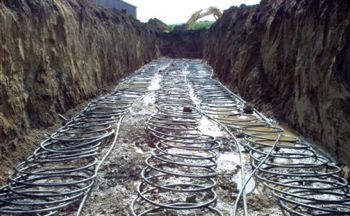Ground source heat pumps (GSHPs) employ the same process as a refrigerator or an air conditioning system. Simply, heat is extracted from one location and transferred to another. This technology and the thermal properties of the ground can provide a renewable alternative for our heating (and cooling) needs.
Ground Heat
The Earth’s surface is heated by radiation from the Sun and the ground below the frost line maintains a more constant temperature than the air above. The Ground Source Heat Pump Association (GSHPA) states that below a depth of 1 metre, the ground maintains a constant temperature of 8 – 12 degrees centigrade.
We can tap into this latent heat and use it in our homes and buildings.

Ground Source Heat Pumps – How They Work
A ground source heat pump system comprises of three parts:
The Ground Loop
Extracts heat from the ground. Pipe work is laid beneath the ground either horizontally in trenches or vertically in boreholes. In a closed system, water and antifreeze is pumped through the pipes, absorbing heat from the ground. In a direct system a refrigerant is used instead.
The Heat Pump
Removes and concentrates the heat from the liquid and transfers it to the distribution system. The cooled liquid is pumped back into the ground loop to absorb more heat. The heat pump is about the size of a large fridge freezer.
The Distribution System
Distributes the heat generated throughout the building by either an air or water based system. GSHPs work best when coupled with a heating system that only requires a lower constant operating temperature. Under floor heating systems are well suited.
The process can be reversed at hotter times of year, cooling your home by removing warm air from living spaces and dissipating it into the ground.
Efficiency
Energy is required to power the pumps and compressor in the system and its overall efficiency is measured using the coefficient of performance (CoP). The CoP shows that ground source heat pumps generate 3-4 units of heat for every unit of electricity used in their operation. By incorporating a renewable power source or using a green energy supplier, the production of any CO2 in the generation of heat for your home can be eliminated.
Costs
Ground source heat pumps are renowned for high installation costs and Energy Saving Trust suggests that a system typically costs between £10,000 – £18,000 in addition to the distribution system.
The payback period is dependent on the costs of the energy source it would be replacing, the specification of the system and the thermal efficiency of the house structure.
Applications
Ground source heat pumps are primarily used for space heating and cooling however they can be used for water heating. Due to the lower temperatures they generate, they are usually only suitable for preheating with additional methods required to fully heat domestic hot water.
If you are pushing the boat out, they can also be used for pool heating or driveway ice prevention systems.
Design and Installation
Design and installation should be completed by an Microgeneration Certification Scheme registered company. They will complete a survey to assess the suitability and characteristics of the ground, the area available, the energy requirements and the heat loss of the house. A system will be designed to meet your needs and circumstances.
GSHPs offer an excellent renewable solution for producing heat. Coupled with another renewable source of power for the heat pump you can generate heat (or cool) for your home without producing any CO2.
Return to Eco Homes
Return to our Home Page from Ground Source Heat Pumps
